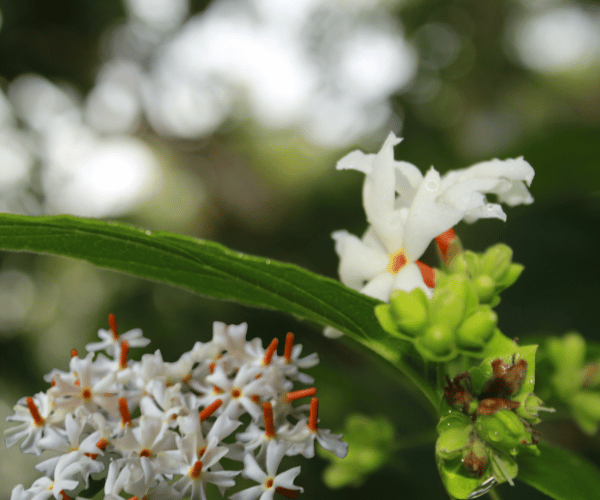Sepalika Tree: An Ayurvedic Treasure for Healing and Wellness – By Nadeeka – eLanka

The Sepalika tree, scientifically known as Nyctanthes arbor-tristis, is a small, flowering tree native to South Asia. In Sri Lanka and India, it is cherished not only for its delicate, fragrant flowers that bloom at night but also for its powerful healing properties. In Ayurveda, Sepalika is called “Parijat” or “Shefalika,” and it has been used for centuries as a medicine for chronic diseases, pain relief, and rejuvenation. This article explores the medicinal uses, cultural significance, and modern relevance of the Sepalika tree.
Botanical Profile
-
Common Names: Sepalika, Night-flowering Jasmine, Parijat, Shefalika
-
Scientific Name: Nyctanthes arbor-tristis
-
Family: Oleaceae
-
Appearance: A small tree or shrub, 10–12 feet tall, with rough gray bark, opposite leaves, and small star-shaped flowers with white petals and a bright orange center.
-
Unique Feature: The flowers bloom at night and fall by morning, carpeting the ground with a fragrant, beautiful layer.
Ayurvedic Perspective
In Ayurveda, Sepalika is considered a plant with tikta (bitter) and kashaya (astringent) tastes, and it has light and dry qualities. It is believed to balance Kapha and Pitta doshas, making it useful in treating inflammatory, metabolic, and chronic disorders. Ayurvedic texts mention its effectiveness in conditions like arthritis, skin diseases, fever, and digestive issues.
Key Medicinal Parts Used
-
Leaves – Most commonly used in Ayurvedic preparations; known for anti-inflammatory and antipyretic properties.
-
Flowers – Used in decoctions and sometimes dried for skin and liver ailments.
-
Seeds – Applied for treating worms, stomach complaints, and hair issues.
-
Bark – Sometimes used in folk medicine for its astringent action.
Traditional and Ayurvedic Uses of Sepalika
1. Joint Pain and Arthritis
Sepalika leaves are renowned for their effectiveness in easing joint pain, sciatica, and arthritis. The leaves contain natural compounds that reduce inflammation and stiffness.
-
Ayurvedic practice: Fresh leaves are boiled, and the decoction is consumed to relieve chronic pain. Leaf paste may also be applied externally to painful joints.
2. Fever and Malaria
Sepalika leaves are considered a natural remedy for intermittent fevers, including malaria.
-
Method: A decoction of leaves with black pepper is used traditionally to reduce fever and associated body aches.
3. Digestive Disorders
The plant aids in improving digestion and treating constipation. The bitter-astringent taste stimulates digestive fire and cleanses the system.
-
Traditional use: Leaf juice mixed with honey or jaggery is given for constipation, flatulence, and worms.
4. Liver Health
Sepalika is often used in Ayurveda to support liver function. The flower extract is believed to detoxify the liver and help in jaundice.
-
Remedy: A decoction of flowers is consumed for mild liver disorders and sluggish digestion.
5. Skin Diseases
Sepalika has antimicrobial and detoxifying properties. It is used in treating ringworm, eczema, and skin eruptions.
-
Topical use: Paste of leaves is applied directly to affected areas to reduce itching and inflammation.
6. Respiratory Conditions
Ayurveda describes Sepalika as beneficial for asthma, cough, and colds. It clears phlegm and improves breathing.
-
Method: Decoction of leaves and flowers is used as an expectorant and bronchodilator.
7. Immune Support and General Wellness
Sepalika is believed to act as a natural immunity booster. Its regular use strengthens the body against infections.
-
Ayurvedic tonic: A mild infusion of flowers is consumed for vitality and rejuvenation.
Modern Scientific Research
Recent studies have confirmed many of the traditional uses of Sepalika:
-
Anti-inflammatory properties: Leaf extracts reduce inflammation in arthritis and related disorders.
-
Antimicrobial activity: Effective against bacteria and fungi, supporting its use in skin diseases.
-
Antioxidant effects: Protects cells from oxidative stress, slowing aging and degenerative diseases.
-
Antipyretic action: Reduces fever, supporting its traditional role in malaria and chronic fevers.
Preparation and Usage in Ayurveda
-
Leaf Decoction
-
Boil fresh Sepalika leaves with water until reduced to half.
-
Drink 20–30 ml twice daily for arthritis, fever, or constipation.
-
Flower Infusion
-
Soak flowers overnight in water.
-
Drink in the morning to support liver health and immunity.
-
External Paste
-
Crush fresh leaves and apply to skin infections, wounds, or inflamed joints.
-
Seed Powder
-
Used sparingly with honey for worm infestations.
(Note: Always consult an Ayurvedic physician before use.)
Cultural and Spiritual Significance
Beyond medicine, Sepalika holds cultural value. In Hindu mythology, the tree is considered divine, associated with the story of Satyabhama and Lord Krishna. The flowers are used in temples, and their nightly blooming symbolizes detachment and surrender. In Sri Lanka, Sepalika is admired as both a sacred and healing plant, linking tradition with daily life.
Safety and Precautions
-
Sepalika is generally safe in recommended doses.
-
Excessive use of seeds may cause nausea.
-
Pregnant and lactating women should use it under medical supervision.
-
Self-medication for chronic conditions should be avoided — always seek Ayurvedic guidance.
Conclusion
The Sepalika tree (Nyctanthes arbor-tristis) is a gift of nature, combining beauty, fragrance, and profound healing power. In Ayurveda, it has been valued for centuries for its role in treating arthritis, fever, digestive disorders, skin diseases, and liver complaints. Modern research is beginning to confirm what traditional healers knew long ago — that this humble tree is a source of potent medicinal compounds.
By integrating Sepalika into holistic healing practices, we preserve not only ancient wisdom but also provide safe, natural solutions for modern health challenges. Truly, the Sepalika tree stands as a living testament to the harmony of tradition, spirituality, and science.























